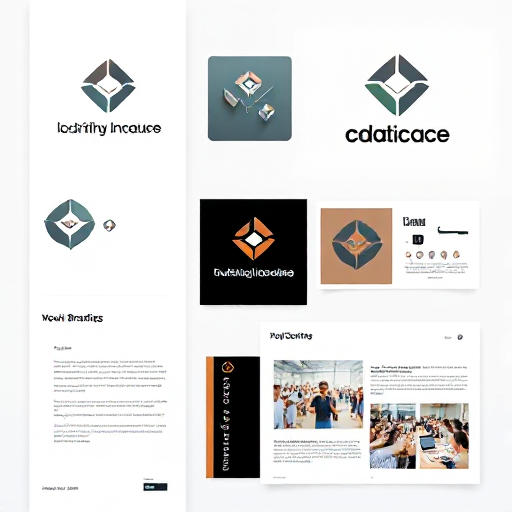Professional Branding with Graphic Design and Content

Professional branding is more important than ever. A strong brand not only sets a business apart from its competitors but also builds trust and loyalty among customers. Central to creating a compelling brand are graphic design and content, two powerful tools that, when combined, can transform the perception of a business. This article explores the importance of professional branding, the role of graphic design and content, and strategies for effectively using these elements to create a cohesive and impactful brand identity.
What is Professional Branding?
Professional branding is the process of creating a distinct and memorable identity for a business or individual that communicates their values, mission, and unique offerings. It goes beyond logos and color schemes to encompass the tone, voice, and overall personality that a brand portrays. A strong brand helps establish credibility, fosters customer loyalty, and influences purchasing decisions.
The Role of Graphic Design in Branding
Graphic design is the visual language of a brand. It involves the creation of visual elements that communicate the brand’s identity, values, and message. Key components include:
- Logo Design: The logo is often the first thing people associate with a brand. A well-designed logo is simple, memorable, and versatile, serving as the cornerstone of a brand’s visual identity.
- Color Palette: Colors evoke emotions and influence perceptions. Consistent use of a specific color palette helps reinforce brand recognition and creates a cohesive look across all platforms.
- Typography: Fonts contribute to the tone and personality of a brand. For example, serif fonts can convey tradition and reliability, while sans-serif fonts often suggest modernity and simplicity.
- Imagery and Iconography: The use of consistent imagery and icons can help communicate brand values and create a unified visual style.
- Layout and Design Principles: The arrangement of elements, white space, and alignment all contribute to the overall aesthetic and user experience of branded materials.
The Role of Content in Branding
Content is the voice of a brand. It encompasses all forms of communication, including written, audio, and video materials. The primary goals of content in branding are to inform, engage, and build trust with the audience. Key aspects include:
- Brand Voice: This is the personality of your brand conveyed through language and tone. A consistent voice—whether it’s professional, conversational, or playful—builds familiarity and trust.
- Storytelling: Sharing the brand’s story, mission, and values creates an emotional connection with the audience. Authentic stories resonate and leave a lasting impression.
- Value-Driven Content: Providing valuable and relevant content, such as blog posts, tutorials, or industry insights, positions the brand as an authority in its field.
- Social Media: Platforms like Instagram, LinkedIn, and Twitter are vital for sharing content and engaging directly with the audience. Social media amplifies the reach of a brand’s message and fosters community-building.
- SEO Optimization: High-quality content that is optimized for search engines increases visibility and drives organic traffic to the brand’s online platforms.
Combining Graphic Design and Content for Effective Branding
When graphic design and content work together harmoniously, the result is a powerful and cohesive brand identity. Here’s how to achieve this:
- Consistent Branding Across Platforms: Use the same visual elements and tone of voice across all touchpoints, including websites, social media, packaging, and advertisements.
- Create Templates and Guidelines: Develop branding guidelines that outline the use of logos, colors, fonts, and content style. This ensures consistency, especially when working with multiple teams or designers.
- Tell a Visual Story: Use graphic design to complement and enhance written content. For instance, infographics can make complex data more digestible, while compelling visuals can draw attention to key messages.
- Engage Emotionally: Pairing evocative visuals with storytelling content can create an emotional connection with the audience, making the brand more relatable and memorable.
- Leverage Technology: Tools like Canva, Adobe Creative Suite, and content management systems (CMS) make it easier to align graphic design and content creation efforts.
Benefits of a Strong Professional Brand
- Increased Recognition: A distinct and consistent brand identity makes it easier for customers to recognize and remember the brand.
- Customer Loyalty: Strong branding fosters trust and emotional connections, encouraging repeat business and referrals.
- Competitive Advantage: A well-defined brand stands out in crowded markets and differentiates itself from competitors.
- Higher Perceived Value: A professional and cohesive brand can justify premium pricing by conveying quality and reliability.
- Enhanced Marketing Efforts: Clear branding simplifies marketing by providing a consistent message and identity to build campaigns around.
Professional branding with graphic design and content is a powerful strategy for businesses and individuals looking to make a lasting impact. By combining the visual appeal of graphic design with the persuasive power of content, brands can communicate their values, engage their audience, and build strong, lasting relationships. In today’s competitive landscape, investing in cohesive branding is not just an option—it’s a necessity for success.






